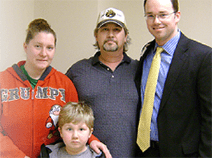Neurosurgeons at UPMC have pioneered a minimally invasive technique for removing deep brain tumors using an endoscope through a small clear tube, called a Neuroendoport®.
This tube, or port, allows doctors to access deep-seated tumors through a smaller opening in the lining of the brain than would be used in traditional brain surgery.
How the Neuroendoport Works
During brain surgery, the neurosurgeon:
- Inserts the Neuroendoport — a small tube about the circumference of a dime — as a channel to guide tumor removal.
- Places an endoscope into the Neuroendoport, providing a powerful light source and excellent images of the tumor or lesion.
- Performs the entire surgical procedure through the Neuroendoport, minimizing trauma to the brain and surrounding nerve tissue.
What the Neuroendoport Treats
The Neuroendoport technique is suitable for tumors within the substance of the brain (the parenchyma) as well as tumors within the fluid-filled spaces of the brain (the ventricles). Metastases from cancer, gliomas, and a variety of tumors within the ventricles are often good candidates for the Neuroendoport approach.
Learn about the conditions treated with Neuroendoport surgery.
Benefits of the Neuroendoport
Neuroendoport surgery offers patients a number of benefits that may improve their quality of life, including minimal scarring, fewer side effects and complications, and faster recovery times than with traditional surgery. Because the entire procedure is performed within a dime-size channel through the brain, surgeons are able to minimize trauma to surrounding brain tissue and nerves.
Learn more about the benefits of Neuroendoport surgery.
Find answers to some frequently asked questions.
Read clinical case studies.

















